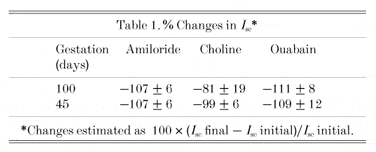A short-circuit current (Isc) is sustained across the isolated chorioallantoic membrane (functional placenta consisting of trophoblast, stroma and allantoic membrane) of the pig when mounted in Ussing chambers and bathed in HCO3– Ringer solution. Positive charge moves from the fetal to the maternal side but it is as yet unclear whether sodium (Na+) is the sole charge carrier.
Large White X Landrace multiparous sows were exsanguinated under deep anaesthesia (8 % v/v halothane), as permitted under UK legislation, and the reproductive tract removed. Strips of placental tissue were mounted so that 0.4 cm2 of tissue was exposed to bathing solution (39 °C) and gassed with 95 % O2 and 5 % CO2. Following measurement of the open circuit potential (PD) (shown positive when maternal side was positive compared with fetal side) the tissue was clamped at zero PD and the Isc and resistance (R) monitored.
Eight tissues from four sows at 45 days gestation, and ten tissues from five sows at 100 days gestation were examined. Initial electrical values (means ± S.E.M.) for day 45 tissues were PD 3.6 ± 1.0 mV, Isc 102.3 ± 18.3 µA cm-2 and R 46.9 ± 17.3 ¢ cm2. Corresponding values for day 100 were 1.9 ± 0.8 mV, 47.7 ± 7.7 µA cm-2 and 74.6 ± 20.6 ¢ cm2. Differences between the two gestational periods were significant for Isc (P = 0.024, Student’s paired t test) but not for PD or R.
Isc was reversibly reduced following addition of amiloride (1 mM) to the fetal bathing solution or by replacement of Na+ by choline+ in both bathing solutions, whilst addition of ouabain (0.1 mM) to either bathing solution irreversibly inhibited Isc (Table 1). In no circumstances did the residual Isc following exposure to amiloride or ouabain, or following Na+ replacement, differ significantly from 0 (Student’s t test). It is concluded that Na+ is the sole charge carrier associated with the Isc at days 45 and 100 and that Isc declines between day 45 and day 100.
This work was supported by SERAD Flexible funds.

